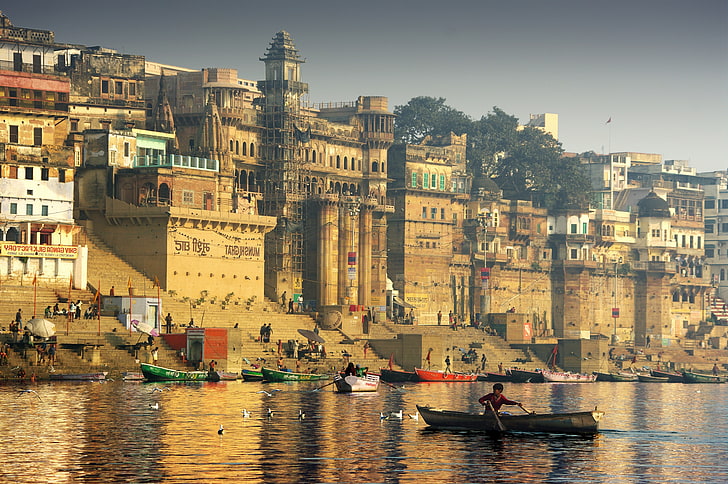OVERVIEW
Varanasi is counted among the cities that have been inhabited since ancient times. Popularly known as Kashi, the city is spiritually as vast as the Ganga herself and hence is called the religious capital of India. Also, Kashi is mentioned in Puranas along with Ramayana, Mahabharat, and Jatak. Known as the city of Lord Shiva, his benediction can be felt in the belief that whoever dies here attains salvation from the cycle of birth and rebirth. This temple city is known for being the heartland of the Hindu renaissance, the land of piety, philosophy, and religious mysticism.
- KASHI VISHWANATH TEMPLE:
One of the most popular and revered shrines of Varanasi is the Kashi Vishwanath Temple. It is one of the twelve sacred jyotirlingas or the ‘lingas of light’. Devotees believe that even a glance of this famed linga can sanctify one’s entire being. In the same complex is the temple of Devi Annapurna Bhavani.
- DASASHWAMEDH GHAT:
One of the most important ghats in Varanasi, Dasashwamedh derives its name from the ten horse sacrifices performed here by Lord Brahma to appease Lord Shiva. One of the primary attractions is the Ganga aarti. Every evening, priests come down to the ghats and worship the Ganga with multi-tiered flaming lamps. Viewed from a boat on the river, it is a visual spectacle.
- SANKAT MOCHAN HANUMAN TEMPLE:
Founded by Goswami Tulsidas, the holy Sankat Mochan Hanuman Temple is believed to grant the wishes and desires of those in distress. According to Vedic Astrology, Lord Hanuman rescues people from the malignant forces of planet Saturn. The famous Prataha Aarti at 5 am every day must be attended by one and all.
- JANTAR MANTAR:
Established by Maharaja Jai Singh in 1737, this observatory is similar to the ones in Delhi and Jaipur. It measures local time, the sun’s declination, altitude, movement of stars, and planets and determines eclipses with the help of yantras or mechanical instruments. Some of the important yantras are the Krantivritta Yantra, Digansha Yantra, Samrat Yantra, Prakash Yantra, Ram Yantra, Disha Yantra, and Dhruva Yantra.
- BHARAT MATA TEMPLE:
Pay your obeisance to the map of undivided India, carved on marble and guarded by five pillars, each one symbolizing the convergence of nature’s elements like earth, wind, fire, water, and sky. Unlike other temples of India, Mother India is worshipped in the Bharat Mata Temple. Established by Babu Shiv Prasad Gupt, the temple had Mahatma Gandhi as its first visitor in 1936.
- BHARAT KALA BHAVAN:
A part of Banaras Hindu University, this museum treasures Hindu and Buddhist archaeological remains. Established in 1920, the hall has a sculpture of a man on one leg, one hand on his hip, and the other handling a huge stone on his head. The museum houses other galleries like Nicholas Roerich Gallery, Chhavi Gallery, Mahamana Malviya Gallery, Nidhi Gallery, Archaeological Gallery, Sculpture Gallery, Decorative Art Gallery, and many others.
- SARNATH:
A little further down the Ganga is the tiny city of Sarangnath, or Sarnath, which is of monumental importance to Buddhists across the world. Here, Gautam Buddha preached his first sermon, revealing his eight-fold path to enlightenment and nirvana, more than 2,500 years ago. The focus is the famous Dharma Chakra stupa, it makes for a poetic experience when the chanting of pilgrims fills the area. The museum has some superb sculptures excavated from the site, mostly 6th or 11th-century Buddhist icons; pride of place goes to Ashoka’s lion capital.
- RAMNAGAR FORT & MUSEUM:
This early 18th-century fort on the east bank is best appreciated from a boat, as it stands directly on the river. To enter it, you’ve to disembark from your boat; you can also reach by auto. It’s a stately but fading structure, in a part of which the royal family stays. The museum is a dusty collection of grand palanquins and howdahs, pistols, rifles, swords, and brocades from the royal collection.
- GHATS OF VARANASI:
Every holy activity begins with a cleansing bath on one of the hundreds of ghats lining the Ganga in Varanasi. It would be safe to say that the life of a Hindu center on the Varanasi ghats. When he is born, he is brought to the ghats for the blessings of the gods, he receives the janeo on its banks and when it is time for him to depart to the other world, his mortal remains are cremated on its banks. No journey to Varanasi is, hence, complete without a visit to the ghats. The chief cremation ghat of Varanasi, Manikarnika Ghat has numerous pyres burning day and night. It is believed that Lord Shiva himself goes near the burning pyre and carries the soul to heaven. Fuelled by this belief, the ghat receives hundreds of bodies every day.
- BANARAS HINDU UNIVERSITY:
One of the internationally accredited institutions, the Banaras Hindu University, or BHU, was founded by Pandit Madan Mohan Malviya in 1916, with Dr. Annie Besant playing a crucial role. Known as ‘Oxford of the East', it is spread over 1,300 acres on the south of the city. The architecture of the university is considered among the marvelous monuments in Varanasi and also houses an airstrip for aeronautical education. The New Vishwanath Temple is situated within the BHU grounds, the Shiva temple was planned by Madan Mohan Malviya and built by the famous Birla family. The Bhagavad Gita is engraved on the walls and shivalinga is the main attraction of this temple.
